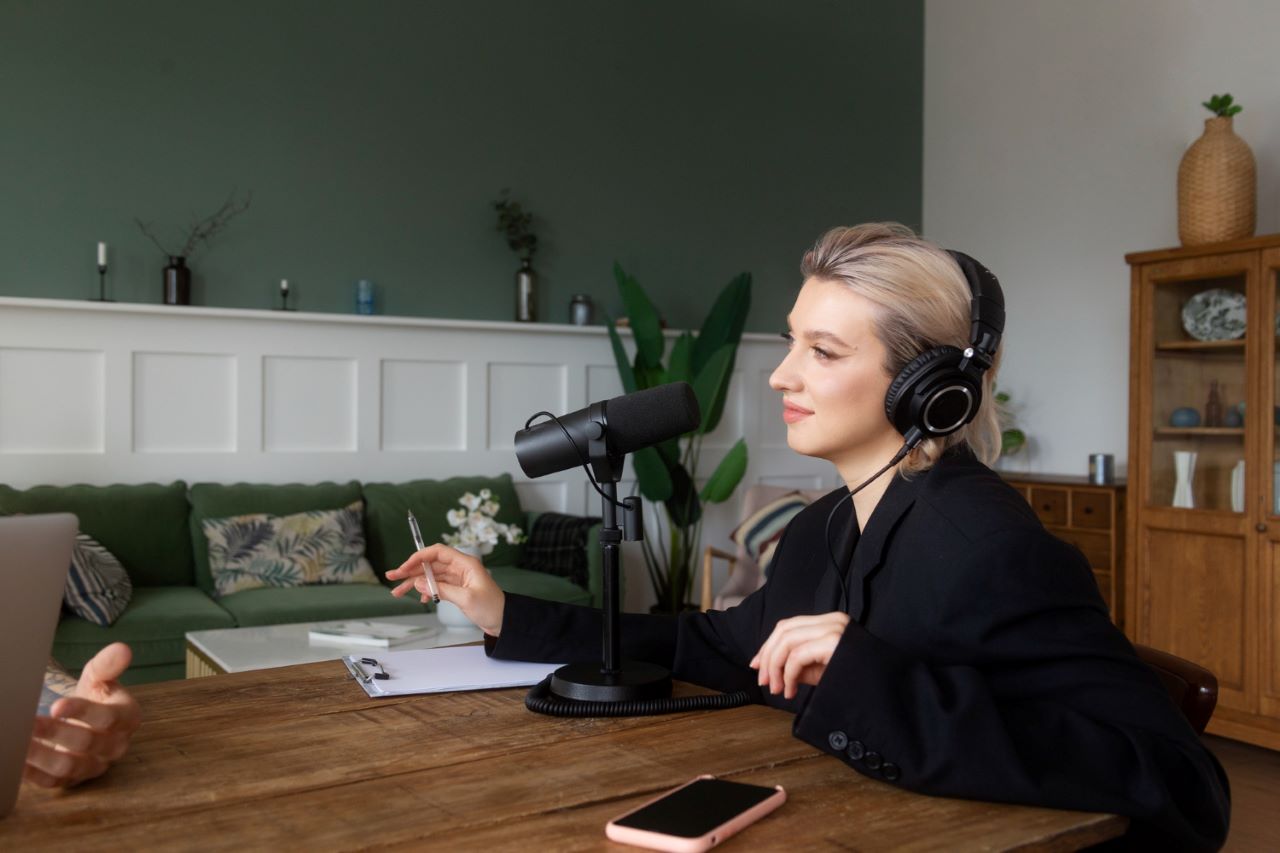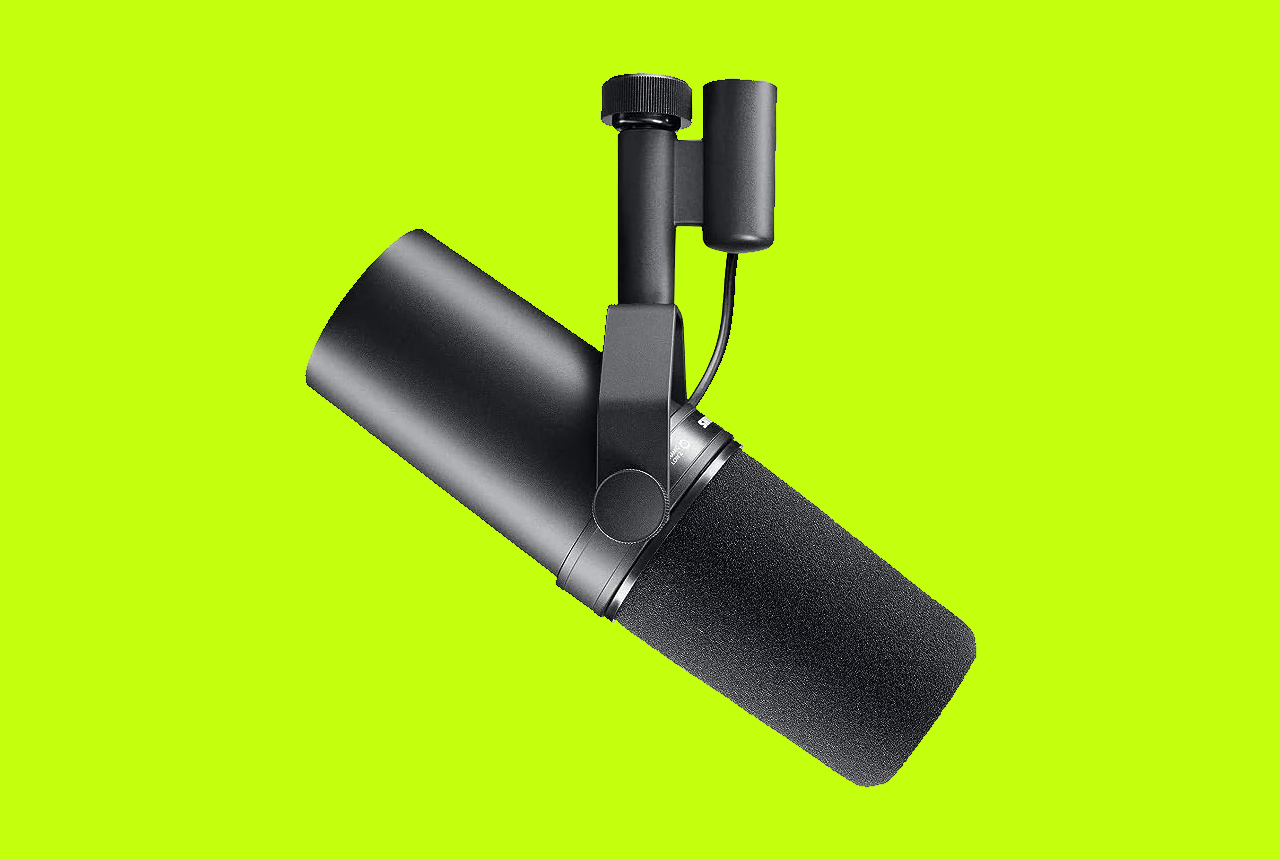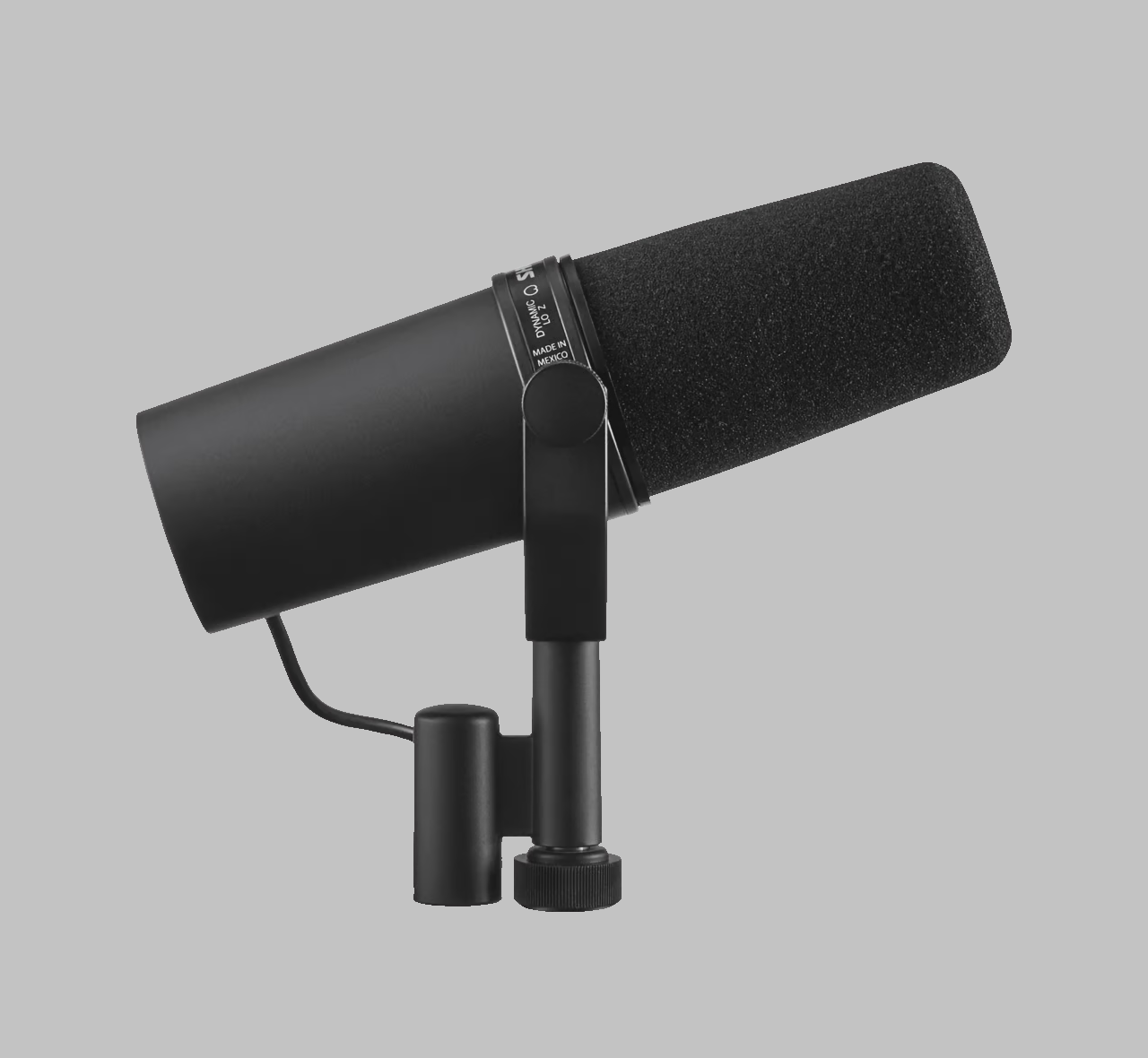In the vast realm of professional audio equipment for podcasting, few debates are as riveting as the one between the Shure SM7 and its updated version, the SM7B. The world of sound engineering and podcast recording reveres these iconic microphones, each earning its place in the annals of audio history.
These microphones, while sharing a lineage, offer distinct features and experiences that can make all the difference in an audio project. Distinguishing between these two isn’t just about model numbers; it’s about understanding the nuances like mid-range emphasis and low-end response that separate a good recording from a great one.
The quest for the perfect sound is a never-ending journey for audio professionals. Factors like recording environments, types of instruments, and personal preferences can all influence the final product. Within this intricate dance of sound manipulation, the microphone, with its mic element, stands as the bridge between the real world and the recorded one.
Choosing the right microphone between SM7 vs SM7B can often be the difference between capturing the raw emotion of a vocal or the intricate details of an instrument, like guitar cabs. With the SM7 and SM7B, Shure has given sound professionals two formidable tools. But understanding features like bass roll-off and the significance of a foam screen is key to harnessing their full potential.
Related: The Best Microphones For Recording in Podcasting
Contents
The Evolution from SM7 to SM7B
From their conception to their performance, every piece of audio equipment tells a story. And when you’re comparing two giants like the SM7 and SM7B, the evolution becomes a narrative worth exploring, even if one needs an audio interface to truly appreciate the difference.
The Original SM7

Image by Freepik
The SM7, a name synonymous with top-tier audio quality, became an industry standard almost overnight after its launch.
Launch Date and Original Purpose
Debuting in 1973, the SM7 was crafted with radio and broadcasting in mind. It was designed to fill a gap in the market for a microphone that could handle the human voice with clarity, use a presence boost when needed, and minimize background interference. The goal was to ensure broadcasters could be distinctly heard without ambient distractions. And boy, did it deliver!
Initial Reception and Market Impact
The SM7’s entrance into the audio market was nothing short of revolutionary. With its impeccable voice articulation capabilities, broadcasters from coast to coast and even internationally began favoring it. By the late ’70s, one would be hard-pressed to find a radio station that didn’t have an SM7 on hand.
The Birth Of The SM7B
The audio landscape, like all industries, is prone to evolution. As needs changed, Shure saw an opportunity to iterate on the SM7’s success.
Reasons For The Iteration
Post the millennium, there was a marked shift in audio demand. Beyond broadcasting, podcasting and home recording were burgeoning fields. Users wanted a mic that was versatile across multiple applications. While the SM7 was good, the SM7B was designed to be better.
Distinctive Features Introduced
With the SM7B, Shure expanded the frequency range, added a larger foam windscreen, and bolstered the electromagnetic shielding, incorporating a humbucking coil improved design, making it robust against hum from nearby monitors and electronics. This was a significant boost, particularly for home studio enthusiasts who often lacked professionally shielded rooms.
SM7 vs SM7B: Physical Design And Construction

The SM7B Air Suspension Shock Isolation & Pop Filter Eliminate Both Mechanical Noise And Breathiness. Image Source.
Physical appearance and build play a pivotal role in the microphone’s performance, longevity, and user experience. The mic mounting yoke ensures stability, while design elements focus on functionality as much as aesthetics.
Build Quality
The core of any good microphone lies in its build. A sturdy construction doesn’t just ensure longevity but also consistent performance. Here’s how the SM7 and SM7B stack up.
- Materials used: Both the SM7 and SM7B are constructed with a combination of rugged metal and high-density plastic. However, the SM7B has a thicker outer grille, which improves its durability, especially in demanding environments like live stage performances.
- Durability and longevity: Over the years, countless reviews and user experiences have attested to the endurance of both mics. However, the SM7B, with its reinforced grille and enhanced build, is often cited as having an edge in longevity, often outlasting other studio equipment.
Aesthetic Differences
In a world where presentation often walks hand in hand with functionality, the design differences between these mics aren’t just skin deep. Let’s see what sets them apart.
- Visual comparison: While both microphones sport a professional, muted design, the SM7B offers a darker, sleeker finish. This not only makes it visually more appealing but also ensures it’s less prone to visible wear and tear.
- Ergonomics and usability: Both mics weigh in at approximately 2 lbs, making them sturdy yet manageable. However, the SM7B’s yoke mounting system and slightly streamlined design ensure it’s a touch more user-friendly, especially during lengthy recording sessions.
SM7 vs SM7B: Technical Specifications
When considering USB connectivity, both the SM7 and SM7B come to mind. Their ability to connect seamlessly with various devices is noteworthy.
Frequency Response
The soul of a microphone’s audio output lies in its frequency response. It defines how well a mic picks up lows, mids, and highs, affecting the overall sound quality.
- The lows, mids, and highs comparison: The SM7 delivers a balanced frequency response, with a noticeable peak around the midrange (between 2kHz and 7kHz). The SM7B, on the other hand, offers a flatter curve, giving a truer representation of the source sound. For vocals, this flatter response ensures that the singer’s voice cuts through the mix with clarity.
- Suitability for specific applications: While the SM7 was primarily designed for voice, the SM7B’s flatter frequency response ensures it’s equally adept at capturing instruments, particularly stringed ones like guitars.
Sensitivity And Noise Floor

Image by DCStudio on Freepik
In the audio world, sensitivity isn’t about feelings; it’s about how adeptly a microphone captures sound. Let’s examine the precision and clarity offered by both models.
- Signal-to-noise ratio: The SM7B comes out slightly ahead, offering a better signal-to-noise ratio. This ensures that recordings are cleaner, even when contending with ambient studio noise.
- Potential interference and self-noise: The SM7B’s superior electromagnetic shielding reduces self-noise and interference from other electronics. This makes it ideal for studio environments where multiple devices operate concurrently.
Impedance And Connectivity
A microphone’s compatibility and the fidelity of its sound often hinge on its impedance and connectivity. Let’s navigate these technical seas to understand what makes these mics stand out.
- Compatibility with audio interfaces and mixers: While both microphones offer broad compatibility, the SM7B, with its lower impedance, has a slight edge, ensuring it seamlessly interfaces with a broader array of audio devices.
- Impact on audio quality: A lower impedance in the SM7B means less signal degradation over longer cable lengths, which can be pivotal in expansive studio setups.
SM7 vs SM7B: Real-World Performance
Whether it’s in a recording booth or on a stage, performance matters. The inclusion of a pop filter is essential in certain scenarios to ensure clarity of sound. In addition, knowing how to adjust the mic gain can influence the final audio output.
Studio Recording
Recording studios are the battlegrounds where microphones prove their mettle. Let’s discover how our contenders perform in this demanding environment.
- Voice-over and broadcasting: While the SM7 set the standard for voice-over and broadcasting, the SM7B upped the game. Its nuanced frequency response ensures voice clarity and richness, making it a go-to for many professional voice-over artists and broadcasters.
- Music production: The SM7B, in particular, has been praised for its role in music production. Its ability to capture vocals and instruments with equal fidelity makes it indispensable in modern recording studios.
Live Sound Applications
The stage is an entirely different beast compared to the studio. How do the SM7 and SM7B manage the challenges of live performances?
- Suitability for stage performance: Both mics, given their robust build, are suitable for live performances. However, the SM7B’s additional electromagnetic shielding ensures it’s less prone to interference from other stage electronics.
- Feedback rejection and onstage presence: The SM7B’s tighter cardioid pattern ensures better feedback rejection, making it less likely to produce those jarring feedback loops during live performances.
Iconic Moments with SM7 and SM7B

Image by Freepik
Every legendary piece of equipment has its moments in the spotlight. From unforgettable recordings to industry endorsements, these moments define a product’s legacy.
Memorable Recordings
Certain tracks stand the test of time, not just for their melodies but for the sound quality that carries them. Let’s explore these moments. From Michael Jackson’s Thriller (recorded with an SM7) to countless modern artists opting for the SM7B, the list of accolades is extensive. Both mics have made their mark in iconic studios worldwide.
The SM7’s claim to fame was undoubtedly its use in the recording of Michael Jackson’s Thriller. Meanwhile, the SM7B has been cited in countless modern recording sessions, though pinpointing a single iconic track is challenging given its widespread use.
Endorsements And Reviews
A microphone’s reputation is often bolstered by those who wield it. From sound engineers to iconic artists, endorsements can seal a product’s legendary status.
- Testimonials from industry professionals: Sound engineers from Abbey Road to Electric Lady Studios have often sung the praises of both microphones. Many cite their reliability, clarity, and overall sound quality as reasons they keep returning to these mics.
- Recognition in industry awards and events: While individual microphones rarely get industry awards, the reputation of the SM7 and SM7B often places them atop recommendation lists at audio events and in industry publications.
Related: Best Shure SM7B Alternative
Price And Value Proposition
While performance and history play their parts, real-world decision often boils down to cost and value. Is the investment worth it? Let’s dissect the financials.
Cost Comparison
In the world of microphones, cost isn’t just a number. It’s a reflection of technology, design, and legacy. At launch, the SM7 retailed for around $289, adjusting for inflation. The SM7B, given its additional features and improvements, came in at a slightly higher launch price. Today, prices fluctuate based on retailers, but the SM7B often comes in slightly pricier, reflective of its enhanced features.
When comparing features, durability, and overall performance, both microphones offer exceptional value for money. However, for those seeking versatility across applications, the SM7B often emerges as the preferred choice, even with its slightly higher price tag.
FAQs

SM7B’s highly effective pop filter eliminates need for any add-on protection against explosive breath sounds, even for close-up vocals or narration. Image Source.
Did Michael Jackson Use an SM7 or SM7B?
Michael Jackson, the iconic King of Pop, used the Shure SM7 during the recording of his groundbreaking album “Thriller.” Bruce Swedien, the chief recording engineer for the album, chose the SM7 for Michael Jackson’s vocals, a decision that would go on to become a significant part of recording folklore.
The choice of the SM7 was influenced by its ability to capture Jackson’s unique vocal nuances, its fullness, and the clarity it provided across a wide range of frequencies. The microphone was particularly effective at capturing the dynamic range of Jackson’s voice, from his hushed whispers to his emotive shouts.
The album “Thriller,” produced by the legendary Quincy Jones and engineered by Swedien, went on to become the best-selling album of all time, and the Shure SM7 played a critical role in capturing the iconic vocals. While the SM7B is an iteration of the original SM7, during the “Thriller” sessions, it was the original SM7 that was used.
This choice reinforced the microphone’s position as a premier tool for professional vocal recording, and its association with such a monumental album only added to its legendary status in the music industry.
Why is the SM7 So Quiet?
The Shure SM7, often described as “quiet,” doesn’t refer to its inability to capture sound, but rather its low output level when compared to some other microphones. Here’s a deeper dive into this characteristic:
- Dynamic Nature: The SM7 is a dynamic microphone, which inherently means it doesn’t require external power (like phantom power) to operate. Dynamic microphones generally produce a lower output level compared to condenser microphones, which are powered and can produce a hotter signal.
- Flat Frequency Response: The SM7 has a relatively flat frequency response. This design is intentional to ensure the microphone reproduces sounds authentically without artificially boosting any frequency range. As a result, it might sound quieter compared to microphones that amplify certain frequencies.
- Design Intent: The SM7 was designed to handle a wide range of input volumes, from soft-spoken words to screaming rock vocals. Its low sensitivity ensures that even loud sources won’t easily clip or distort. However, this means when recording softer sounds or voices, the output can be lower than expected.
- Usage with Proper Gear: Given its low output, the SM7 benefits from being paired with a high-quality preamp. A good preamp can provide the necessary gain boost, allowing the microphone to deliver a robust signal without introducing noise or distortion.
In essence, while the Shure SM7 may be “quiet” in terms of its output level, this trait can be an advantage in specific scenarios, especially when capturing loud sources. It’s essential to understand this characteristic and pair it with the right equipment to harness its full potential.
Related: Why Is My Shure SM7B So Quiet?
Conclusion
The expedition through the landscapes of the SM7 and SM7B is nothing short of enlightening. From their historical inception to the nitty-gritty of their technical specifications, it becomes clear why these microphones have become the stuff of legends in the audio world.
While the SM7 laid a robust foundation, the SM7B built upon it, taking the legacy forward with enhancements suited for modern-day applications. Yet, choosing between them isn’t a matter of which one is superior but rather, which one aligns more closely with individual needs.
The choice between the SM7 and SM7B goes beyond mere specifications and enters the realm of artistic intent. It’s about understanding the project’s requirements, the ambiance one aims to create, and the kind of sound signature that resonates with the audience.
Both mics stand as a testament to Shure’s commitment to delivering unparalleled audio quality, and the debate between them, while fascinating, ultimately underscores their shared excellence. As sound aficionados and professionals ponder their next microphone investment, the SM7 and SM7B remain two stellar options, each echoing decades of audio excellence and innovation.